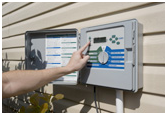Manage Your Irrigation System
If your home is one of the more than 13.5 million with an in–ground irrigation system, try some of these simple strategies to reduce your water waste and protect the environment. Having a beautiful landscape doesn’t have to mean using a lot of water.
Look for the label.
WaterSense labels irrigation controllers, a type of "smart" irrigation control technology that uses local weather data to determine whether your sprinkler system needs to turn on. WaterSense labeled controllers can help you save water, time, and money when compared to use of a conventional controller. Learn more about the ins and outs of upgrading your system with this smarter technology.
Adjust your irrigation system often.
Get to know the settings on your irrigation controller and, if you haven't upgraded to a weather-based controller, adjust its watering schedule regularly to conform to seasonal weather conditions. A good rule of thumb—when you adjust your thermostat due to seasonal temperature changes, adjust your irrigation controller watering schedule as well.
Set sprinklers to keep the water on the landscape and off the pavement.
Lots of water is wasted by poorly designed and neglected sprinkler systems that spray sidewalks, driveways, and the street. Monitoring and making simple adjustments to the sprinklers saves water and reduces runoff from the landscape, helping to keep local water bodies clean.
Play "zone" defense.
Schedule each individual zone in your irrigation system to account for the type of sprinkler; sun or shade exposure; and type of plants and soil in the specific area. The same watering schedule rarely applies to all zones in the system.
Check for WaterSense!
A certified irrigation professional can design, install, maintain, or audit your system to ensure you're using the proper amount of water to support a healthy landscape. Ask if your irrigation contractor is certified by a WaterSense labeled program, a mark of distinction that means he or she has been certified by a program that focuses on water efficiency.
Inspect your irrigation system monthly.

Check for leaks, broken or clogged heads, and other problems, or engage a certified irrigation professional to regularly check your system. Clean micro-irrigation filters as needed and correct obstructions in sprinkler heads that prevent them from distributing water evenly.
Use smart(er) technologies.
Consider installing other water-saving technologies such as soil moisture sensors, efficient sprinkler heads, and micro or drip irrigation to get the most out of your irrigation system.
Install low-volume micro-irrigation for gardens, trees, and shrubs.
Micro-irrigation includes drip (also known as trickle), micro-spray jets, micro-sprinklers, or bubbler irrigation. Micro-irrigation devices irrigate slowly and minimize evaporation, runoff, and overspray.

